Cognition Unit #4
1/107
There's no tags or description
Looks like no tags are added yet.
Name | Mastery | Learn | Test | Matching | Spaced |
|---|
No study sessions yet.
108 Terms
General Intelligence
Spearman’s g influences performance across all cognitive tasks. Intelligence is a single pool of abilities and resources.
Multiple Intelligence
Gardner. Types of intelligence act individually with each other.
What is an example of general intelligence?
Because of this general capacity, if you're good at one type of task (e.g., math), you're likely good at others too (e.g., verbal).
What is an example of multiple intelligence?
An individual that can multiply three digit numbers in their head, or someone who can recall historical dates despite experiencing cognitive deficits.
How might general/multiple intelligence inform our thinking about individual differences?
General view supports standardized testing; multiple intelligences support tailored education and highlight individual differences.
Cognitive Style
A habitual and preferred means of approaching cognitive tasks (i.e. Closed mindset vs. open mindset)
True or False: Mnemonics is NOT a type of cognitive style.
False. They are mental strategies to aid in problem-solving tasks.
Field independence
Reliance on internal referents in processing information.
Field Dependence
Reliance on external referents, more advantageous for others to find various connections between items.
True or False: Field-independent people find it EASIER to identify parts of a figure as separate from the whole.
True. Thinking about objects separately.
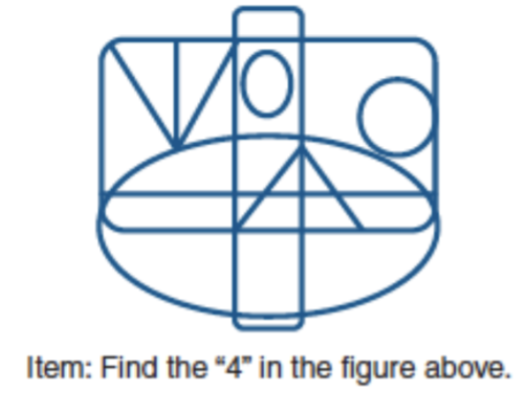
Method: Showing geometric images. Find the type script number ‘4’ in the image. Would this be difficult or easy?
Results: Field-dependent individuals have a more difficult time with these kinds of items than field-independent ones because they are hindered by looking at the figure as a single entity.
Cognitive Styles (Witken et al, 1962, 1981)
Method: Trained young and older participants on both types of cognitive styles.
Results: Showed that there were clear age differences in styles. Younger children were more field dependent while adults were more field independent.
Implications: Predispositions to styles were not alleviated by training. If a child is trained to perform well for a cognitive style that is their weakness, then they weren’t able to perform or process information well.
Cognitive Styles (Zelnicker, 1989)
Question: Are some people visual learners and others verbal learners?
Method: Field-dependent and –independent learners were presented with information auditorily or through an interactive lecture.
Hypothesis: Expected that field-independent would do better with auditory information than field-dependen,t and field-dependent would do better with interactive lectures.
Results: The latter was marginally supported. Why are we not seeing differences across these modes?
Learning Styles (Rollock, 1992)
Question: Is there evidence for effective learning styles depending on the kind of learner you are?
Results: No real evidence that learning tailored to a learner’s style will allow people to learn more effectively, and how information presented in a congruent way to a given learning style will result in any better learning performance.
Implications: You can learn with auditory information as a visual learner, or learn with visual information as an auditory learner.
Learning Styles (Pashler, McDaniel, Roher, and Bjork, 2009)
Experts
Those who have an increased amount of or experience with a given set of knowledge, solving problems with analogical reasoning.
Novices
Those lacking such information or experience (“Lay people”–average person who does not have the same level of knowledge)
Naïve biology
The study of biological principles and the animal world provides a useful test case for expertise.
Experiment Subjects: Commercial fishermen vs. NU undergrads
Method: The goal is to count the number of ways the groups categorize the creatures.
Results: Both grouped marine creatures taxonomically, though the fishermen also took into account commercial significance, behavior, and environment (thematic). But, fishermen were able to tell them where they live in the ocean (shallow vs. deep waters), or how much they can sell the fish. The second part is the reasoning part of the experiment, so they would ask about a made-up disease. Fishermen tended to use thematic and causal relations (predator or prey relationships)–other decision-making–when reasoning, especially about the transfer of disease (X eats Y so X will get the disease that Y has).
Implications: Experts perform better due to flexible reasoning because as you get more connections between the information, the more relationships are created.
Expertise (Shafto and Coley, 2003)
True or False: Tree experts use casual knowledge AND diversity-based approaches to explain projections about diseases.
False. Expertise is increased flexible reasoning and moving away from reasoning like typicality and diversity because you are able to find more connections.
True or False: There are no gender differences in verbal ability.
True. 66% of studies showed no significant differences. It was more likely that the women’s suffrage movement helped fill in the gaps between women’s education and men’s education.
True or False: In verbal ability, women are superior with using anagrams, speech production, and general ability.
True. Despite no significant gender difference.
Mental rotation shows a reliable gender difference, with men outperforming women. The difference is generally in the speed with which men can perform mental rotation tasks. But, there is a strong effect on the timing of their menstrual cycle and their performance on mental rotation effects.
High testosterone levels - Men perform better
High Estrogen levels - Women perform worst, but depends on their menstrual cycle
Gender Differences in Spatial Ability (Shepard & Metzler, 1978)
Experiment: Since we socialize women/men differently at a young age, the differences reflect on the experiences they faced as a child.
Method: Males and females were asked to either undergo training or not before completing a mental rotation task. The training requires playing a game: Play Medal of Honor - Pacific Assault. This was compared with solving puzzles, so that they can see if there are differences in how the game affects their mental perceptions. Would training effects persist?
Result: Women were able to improve more in their spatial ability when they were trained.
Implications: Gender differences are heavily mitigated after training. Girls are socialized to play with dolls and boys are socialized to play video games, creating a significant difference in their spatial abilities.
Gender Differences in Spatial Ability (Feng, Spence, & Pratt, 2007)
True or False: Being from a higher SES background leads to BETTER performance in spatial tasks.
True. If you are born in a lower SES family, you have limited access to toys and less accessibility to “practice” spatial tasks.
True or False: Boys and girls show similar math ability through elementary school (basic arithmetic and geometry), but differences occur more in algebra, where boys outperform girls in high school.
True. There are gender differences in quantitative ability because boys’ achievement increases more rapidly at age 12 or 13, even gifted seventh- and eighth-grade boys outperform girls on the math SAT.
Stereotype Threat
Groups, especially minority groups or groups with less social power (females, ethnic minorities) may perform less well when they are told that they should–in other words, your abilities are challenged by society.
True or False: Asian Model Minority Stereotype is NOT a type of stereotype threat.
False. The negative stereotype is activated regardless of an individual’s skillset, following a self-prophecy.
Question: Are there gender differences in quantitative ability?
Experiment: Alleviate stereotype threat and evaluate performance level. Males and females with high math ability were chosen to participate.
Methods: Males and Females were provided with either an easy or a difficult math test
First part: Easy vs. Hard math test for women and men
Second part: The difficult test was split into two halves. Participants were either told the test had gender differences, or “You may have heard that men outperform women on a particular math test, but the test is gender neutral.” (despite seeing gender differences in the 1st part)
Results:
First part of the experiment: Men and women perform equally well on the easy test. But men perform better than women on the difficult test.
Second part: The group that was told that there were no gender differences in the test, then the women and the men performed similarly in scoring correctly in the tests. The group that was told that there were gender differences, the women performed significantly poorly compared to the men.
Analysis: The negative stereotype was alleviated in the ‘no gender-difference group’, suggesting that the instructions given by the researchers changed the expectations of the participants.
Stereotype Threat (Spencer, Steele, & Quinn, 1999)
WEIRD sample (Arnett, 2008)
Western - U.S., Canada
Educated - Minority group among the workforce where people have a college degree
Industrialized - Opportunities
Rich - ‘Rich’ in resources whether that is family support, academic scholarships, or athletic scholarships.
Democratic - Structures of government–form of democracy or republics. What is not included: Communism (things that are promoted or restricted)
What are the issues with generalizations (i.e. WEIRD sample)?
Lacks representation for the whole population. It is important to have representation across the broad range of humans. Culture psychology takes the findings and sees if they apply in other cultural contexts.
What is culture (Ember & Ember, 1985)?
Learned behaviors, beliefs, and attitudes that are characteristics of a particular society or population.
True or False: Skills, knowledge, beliefs, and type of environment are different ways to see differences in culture across groups.
True. A shared way to understand what is going on with the world.

Ponzo Illusion - Effect of culture on perception
Illusion allows us to see depth in images. The brain processes the image in a 3D space. As the train tracks converge, the lines become longer because they cover more space when the tracks are closer.
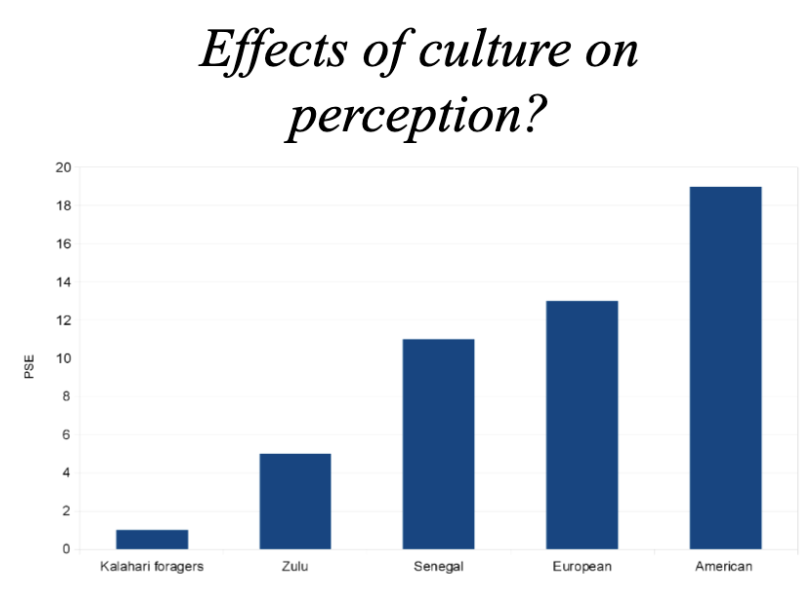
Question: What are the effects of culture on perception? Will people from different cultures be differentially susceptible to visual illusions?
Experiment: Cross-cultural studies of 17 societies
Hunter-gatherers from the Kalahari Desert
Australian Aboriginal foraging culture
Filipino horticulturalists
US midwesterners
Results: Americans and Europeans live in highly constructed environments (modern industrialized society) and make more visual perception mistakes. While hunter-gatherers live in no manufactured environment, they did not make a lot of mistakes.
Analysis: Your perception is built from previous experience. You are not susceptible to visual illusion when you live in a less structured environment.
Ponzo illusion and Müller-Lyer illusion (McCauley & Heinrich, 2006)
“Carpentered World” hypothesis
If groups differ in their interpretation of visual stimuli, it is because their environments differ.
True or False: Groups surrounded in an environment with more constructed perspective cues are more susceptible to visual illusions.
True. Others from environments, like being surrounded by nature rather than urban areas, with very few constructed perspective cues, are not using perspective cues. Less likely to be susceptible to simplifying their environment.
True or False: People from carpentered environments are less susceptible to the Ponzo illusion and the Müller-Lyer illusion.
False. Your perceptions are based on your knowledge of structure, which is based on your experiences! Carpentered spaces have more visual illusions than less carpentered spaces.
Experiment: Tests of memory for spatial relationships among Aboriginal and White Australian children
Aboriginal children: Desert environment. Few outstanding features, widely spaced. Landmarks are not visually distinct.
Navigation may rely heavily on memory for relationships between objects.
White Australian children: Modernized environment. “Built-up” environments, regular structures, and roads.
Navigation may rely on established routes and distinct landmarks–Rely on regular planning.
Results: Aboriginal children outperformed White Australian children in memory for spatial relationships. They approached remembering their spatial surroundings differently:
White children employed verbal memory strategies.
Aboriginal children employed visual strategies to remember their relationship with each other.
Analysis: Approach their visual perception based on their past experiences. Culture can encourage the development of specialized skills, like visual rehearsal strategies.
Effects of culture on visuospatial memory.
True or False: Individualist cultures think, “Despite these expectations, I want to do it this way.”
True. Individualist cultures (e.g., USA, Canada) hold views that are contextualized, and they behave according to personal preferences.
True or False: Collectivist cultures think, “My behavior depends on the good of the group.”
True. Collectivist culture (e.g., China, Japan, Korea) have relation views between themselves and the group. They behave according to group norms.
True or False: Minorities adapt to individualist views and cultures.
False. Adapt collectivist orientations due to being marginalized by individuals in power.
True or False: Being a COLLECTIVIST affects one thinking to adapt to HOLISTIC thoughts.
True. Attention oriented toward field. Attend to relations among objects and/or events.
True or False: Being an INDIVIDUALIST affects one thinking to adapt to ANALYTIC thoughts.
True. Decontextualize object from field. Attend to properties of object. Categorize and predict object’s behavior.

Question: How can you test how culture has influence to one’s cognitive style and thinking?
Method: US (individualistic) and Chinese (collectivistic) participants. People are told to orient themselves in a way that makes sense for them.
Results: Based on their collectivist values, Chinese participants are more likely to orient the rod to the angle of the frame (more influenced by the context). Based on their individualist values, US participants are comparatively immune to the contextual clue (the frame).
The rod and frame task. Field dependence / Field independence.

True or False: The one on the left represents Field Independence while the one on the right represents Field Dependence.
False. Create a single context vs. Think that the two objects are separate.
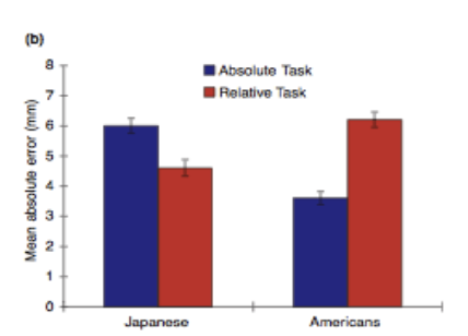
Method: The framed line task, where the participants reproduce the line from a bigger frame onto a smaller frame.
Absolute task: What did it look like originally? Create a line that is exactly the same size line in a smaller frame vs. a larger frame
Relative task: Take a rod that takes a smaller space in a smaller frame due match the relativity.
Results: Japanese made more mistakes in the absolute task but performed better for the relative task. And vice versa for Americans.
Analysis: Members of collectivist cultures tend to be holistic thinkers, attending to the situation and context and struggling to see the actual measurement. Members of individualistic cultures tend to be analytic thinkers, attending to objects’ attributes and struggling to create the relationship between the line and the frame.
Culture and analytic v. holistic thought (Kitayama et al.,2003)
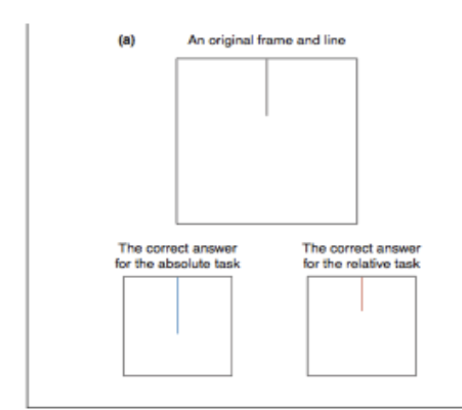

Experiment: The difference in thinking between different cultures. The logic of this experiment is that the order you name things represents what you perceive and pay attention to the most.
Method: Participants (Japanese vs. American subjects) were asked to report what they saw in the clip.
Results: Japanese subjects started their descriptions by referring to context information (“it looked like a river”). American subjects referred first to salient focal objects (“it was a picture of three fish” – frontal and focal attributes of the picture)
Analysis: Overall, Japanese participants reported 60% more information about context than Americans.
Culture and analytic v. holistic thought - First Part (Masuda & Nisbett 2001)
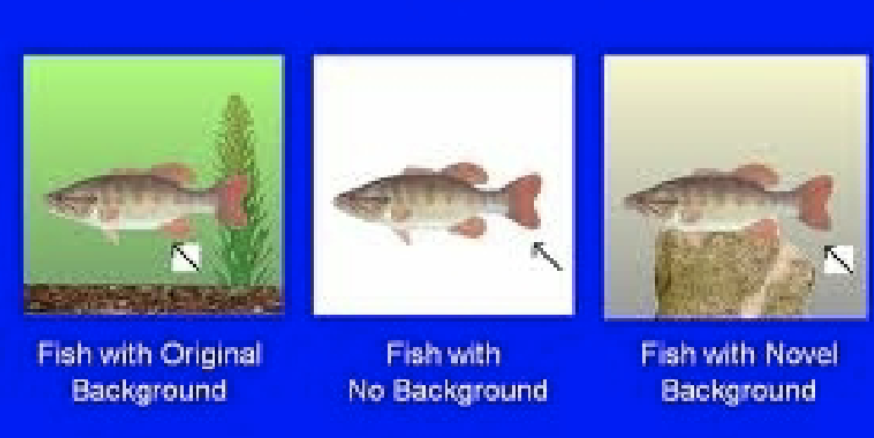
Method: Test of recognition memory - Participants presented with objects they had seen previously. Do you recognize this objects?
Results: Americans' performance unaffected by background manipulation. Japanese participants' performance was impaired when the background was novel. The Japanese rely on the background to remember the objects from memory. If you change the context, things get uncertain for the Japanese.
Analysis: The context and the associations created from the fish and the background are strongly encoded. Attention from both participants are coming from different places, affecting their memory differently. Suggests that the attention of Westerners and East Asians is directed differently
Culture and analytic v. holistic thought - Second Part (Masuda & Nisbett 2001)
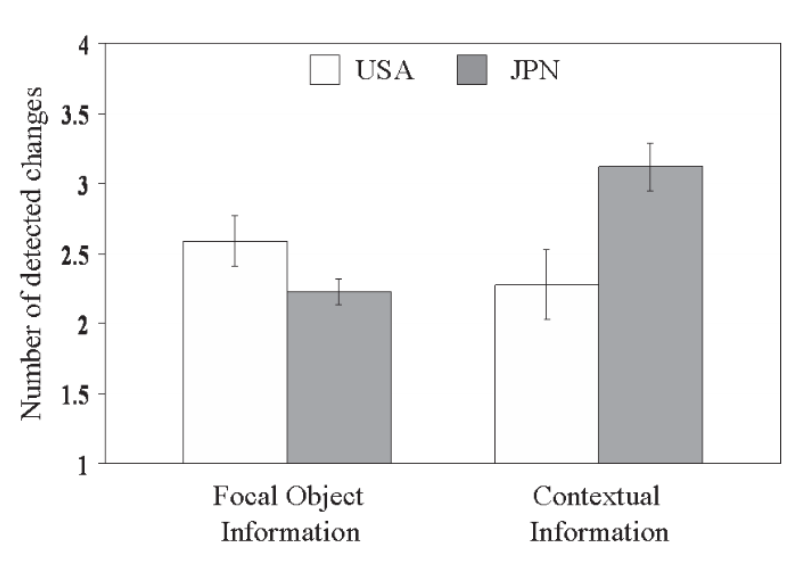
Experiment: People often fail to detect marked changes in their surroundings.
Method: The Flicker paradigm. American vs. Japanese students were presented with still photos and animated vignettes and asked to detect differences in focal object information and contextual information.
Results: The focal changes are better detected by American participants. The contextual changes (happening in the background) are better detected by the Japanese participants.
Culture and change blindness (Masuda & Nisbett 2006)
True or False: Collectivists are susceptible to fundamental attribution error.
False. Individualists tend to assume that the behavior they see someone engaging in reflects on their true personality, having more essentialist influences on their thinking.
True or False: A collectivist thinker attributes a person’s personality situationally and will look for alternative solutions for someone’s negative behavior.
True. They are susceptible to the disposition attribution error, relying on the context.
1. Taxonomic (category-based) classification. Similarity of attributes.
Ex. A moose and a squirrel
2. Thematic (relation-based) classification. Causal, spatial, and temporal relations among objects.
Ex. Squirrel and tree
Categorization (Ji, Zhang & Nisbett, 2004Ji, Zhang & Nisbett, 2004)

Hypothesis: Analytic thinkers should make taxonomic, category-based classification salient while Holistic thinkers should make thematic, relation-based classification salient.
Methods: Subjects are European Americans vs. Mainland Chinese in China
Predictions:
Euro-Americans => Individualistic => Analytic => Taxonomic Categorical Classification
Chinese => Collectivistic => Holistic => Thematic Relational Classification
Results: Chinese participants have a preference for thematic choices. Americans focus on taxonomic categories.
Analysis: Being consistent with the Analytic/Holistic distinction, culture has a substantial influence on classification. Chinese conceptual organization is more relational. American conceptual organization is more taxonomical and categorical.
Culture & Classification (Ji, Zhang & Nisbett, 2004)
True or False: Cognitive phenomena cannot be said to describe human thought until they describe all human thought.
True. People come from different cultures and one culture is NOT representative of overall human thought.
Being able to see things despite being blind. Teach us that vision is not entirely seeing, but there can be a disconnection to respond to visual stimulation and seeing. From the eyeball to where we process visual stimuli, there are two different pathways. One pathway is the new, more sophisticated one that goes from the eyeball to the thalamus and the visual cortex of the brain. The visual cortex is required to consciously see something. The older pathway is seen across mammals, reptiles, and aves go from the brainstem and is relayed to the higher centers of the brain. This is concerned with reflexive behaviors where you response to a visual stimulus from the outside world. The patient no longer has the visual cortex, but the other pathway is still intact which allows them to predict movement of objects even without seeing. Similar to reptiles, which recognize the direction of movement. Blindsight allows us to function on autopilot because we cannot process all visual stimuli.
Blindsight
Found in Amputees, where they can feel pain in a physically absent limb. In the brain, there is a map of surfaces of the body where a part of the somatosensory cortex corresponds to a part of the body. The face corresponding point resides next to the hand, so when the hand no longer receives input from the cut-off limb, the face sensory input activates the area of the hand region. This allows the brain to misinterpret the signals, allowing re-circuitry and neural pathways of the brain to change. You can get a phantom in any part of the body, like phantom appendix pain, even if the appendix was removed. BUT, you cannot have a phantom brain. Overall, phantom limb pain suggests that the brain deludes us into thinking that something is there when it is not.
Phantom Limb
Profound delusion that a loved one is pretending to be said loved one. Believing that their loved ones are impostors. “You cook like someone I know, but that someone cooks way better than you.” Also have the delusion to think that that their house is not their real house. They can also refer to themselves as an impostor. It cannot be linked to a Freudian complex. Seeing is a multi-process where you can look at something, and then you feel some emotion. These process happen separately where the visual stimuli is relayed to the amygdala, the center of emotions. The message gets into the temporal lobe and evokes the appropriate memories, however, the fibers between the temporal lobe and the amygdala are cut. Therefore, there is no warmth when they see a loved one, thinking that the person is an impostor of their loved one. On the phone, they recognize their loved one. This all suggests that there is a separate pathway between the auditory complex and the visual complex into the temporal lobe, so the fiber between the auditory complex to the temporal lobe is not cut, and the amygdala can process the emotion of hearing their loved one. The experiment shows that seeing the picture of the loved one did not evoke a physiological response, thus not feeling emotions towards them. Thus, the lack of emotion implies that all emotions are important to the recognition process of the brain.
Capgras Syndrome
Properties of Consciousness
A state of awareness of sensations or ideas.
Access to what it “feels like” to have sensations and ideas–being able to think absent of sensations and ideas (more narrative).
A causal connection between thought and behavior; free will.
Constant awareness of receiving information and understanding of what it means → Does that give you free will and choice?
“An unfolding story that we tell ourselves, moment to moment, about what we are doing, feeling and thinking.” (Barash, 2006)
Internal monologue–putting your story in perspective of how you feel. The narrative you generate for yourself.
Awareness that people have about the outside world and their perceptions, thoughts, memories, and feelings (Chalmers, 2007)
External monitoring - Being aware of what is going on in the environment
Internal monitoring - Your own thoughts and feelings–evaluating the differences between what you think and external information.
True or False: Phenomenal Consciousness is NOT subjective.
False. The “hard problem” of consciousness - What it feels like to have certain experiences (narrative reflection).
True or False: Access Consciousness does NOT test how sensitive people are to the information they are given.
False. The “easy problem” of consciousness - The degree to which information about the content of your mental operations is available to you.
What is an advantage of introspection as a window to one’s consciousness?
People like Wundt assumed the mind could observe its inner workings, providing rich qualitative data of people’s experiences and having first-person access.
True or False: The mere exposure effect does NOT show why introspection may be limited to accessing one’s consciousness.
False. We do not know our own motives because we tend to prefer things we've seen more often—even without consciously recognizing them. People often can’t introspect why they like something—they just feel that they do.
True or False: The Prisoner’s Dilemma DOES show why introspection may be limited to accessing one’s consciousness.
True. In reality, the prisoners do not say anything despite the bribe and do not create the optimal outcome because, unconsciously, they may have done it to avoid guilt or retaliation, acting in their self-interest.
True or False: Blindsight people cannot do effortful processing to be consciously aware of what is in front of them, but are still able to detect the feature.
True. The conscious part is inaccessible, making them blindsight. Detecting the moition/intense light comes from the processing of unique visual features–feature integration theory where you can detect shapes and color alone.
True or False: Our intuition does not match with the actual results.
True. Examples are from mere exposure effect and prisoner’s dilemma.
True or False: Perception without attention is NOT an example of cognitive unconscious.
False. Our performance on cognitive tasks often relies on processes going on “behind the scenes”, allowing mental activity to happen without much awareness.
True or False: Tasks that involve perception without attention are effortless.
True. Examples are object recognition, categorization, calling information into memory, reporting on the contents of working memory, recognizing spoken language, and making judgments.
Mental products
What we are consciously aware of
Mental processes
The notion of creating those mental products, which we are often unaware of.
True or False: Perceptual illusions is an example of cognitive unconscious.
True. Mental products are fully made aware of, but very little information on mental processes.
True or False: Memory is NOT an example of cognitive unconscious.
False. Examples include the office-with-no-books-study where their expectation of what should be in a university room did not match up with the reality of no books in the waiting room. Eyewitness testimony is also an example of where misinformation could have been processed.
True or False: The phonemic restoration effect is an example of cognitive unconscious.
True. Arises in language where mental products were created by the context of the last word to fill in “*eel*”, but the mental process is not known.
True or False: The effect of mental set is NOT an example of cognitive unconscious.
False. Demonstrates how our problem-solving may be prone to sticking with what we know, focusing on familiar solutions while overlooking potentially better alternatives.
True or False: The heuristics and framing effects are examples of cognitive unconscious.
True. In our reasoning and decision-making, they do not line up because we tend to take shortcuts, or how something may be framed a certain way to influence us to not put into effortful thinking.
What are the pros of a cognitive unconscious?
Quick and efficient cognitive processing. Allows us to direct our attention elsewhere. Involved in inferences.
What are the cons of a cognitive unconscious?
Unconscious processes are inflexible (rigid). Difficult to turn off the efficiency of many cognitive processes (sometimes impossible).
Question: What do we need consciousness for?
Dual Processing Theory (Kahneman, 2003)
True or False: Automatic Processing is the first system of Dual Processing Theory.
True. The unconscious. Includes heuristics and biases.
True or False: Controlled Processing is the first system of Dual Processing Theory.
False. The conscious. Limited to effortful resources that can be used for complex tasks or override system 1.
True or False: Working memory (WM) creates consciousness.
False. However, it is responsible for the selection and maintenance of information we are currently aware of. It integrates information from different sensory systems and LTM to create multi-modal representations of the current state of affairs. Given the appropriate mental resources—or capacity of WM—we can maintain this information as a conscious, controlled experience. Again, sometimes we do not have the information we need.
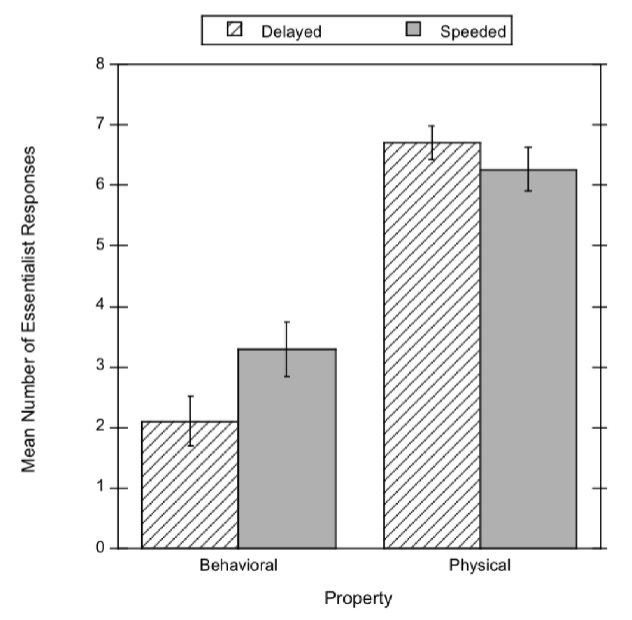
Method: Time Pressure - Participants made responses within 2 seconds
Hypothesis: Kids were more essentialist while adults would say that their environment will affect their behaviors.
Results: Time Pressure results in increased essentialist responding.
Implications: Essentialist thinking never goes away, but with enough time and resources, then you can oppose this essentialist thinking whether it is motivational or not by using your working memory (using consciousness).
Switched-at-Birth paradigm adapted by Gelman & Wellman (Eidson & Coley, 2014)
True or False: Presumably time pressure limits access to effortful reasoning and leaves automatic biases partially exposed.
True. Dual Processing Account of Essentialism.
What did Alex the Parrot help us learn?
Parrots’ ability to understand questions—Demonstrates that he can answer questions from anybody without associating the question with his trainer’s voice. He can selectively apply the questions to the objects. Vocabulary of 100 words. Recognized 50 objects. Discriminated material by using shape and color. Conceptually understand quantity and quality of objects.
True or False: Alex the Parrot did NOT demonstrate numeric cognition.
False. Demonstrated ability to learn new quantities. Through bootstrapping, when she introduced new quantities, Alex the parrot learned those larger quantities quickly (10 vs. 1) and the quantity of zero. Suggesting that Alex can use previously learned information to quickly learn new information (i.e. Piaget’s accommodation).
True or False: Birdsongs have zero parallels with human language.
False. They have the following shared qualities:
Critical Period: Birds raised in cue-deprived environments have difficulty acquiring their birdsong later in life
They require input from mature birds in order to develop their song
Songs are species-specific
Various song accents (depending on geographic area)
True or False: Birds do not need as a complex language as humans do.
True. The language of birdsongs portrays reduplication, or repetition of language elements with small changes (can be morphological, or tone- and expression-based) to affect changes in meaning.
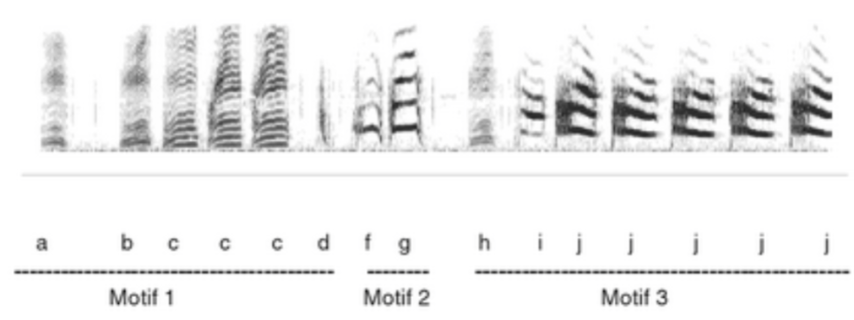
True or False: Bird songs have the component of language where it can be infinitely generated.
False. The language is solely for mating, not for sharing goals or feelings.
True or False: Low-order cognition abilities may be shared between nonhumans and humans.
True. Examples include reflexes, learning, attention, perception, and memory.
True or False: These cognitive abilities can be found across ALL species
Reasoning/decision making
Language (limited because of the use of pheromones, or limited language?)
Problem-solving
Consciousness
False. High-order cognitive abilities are complex.
While children are promiscuous teleologists, adults are selective in their endorsement of teleological beliefs.
Under time pressure, adult undergraduates were more likely to endorse teleological beliefs for natural phenomena (e.g. “The sun makes light so plants can undergo photosynthesis.”)
The cognitive bias to endorse teleological explanations of the world does not disappear or get replaced in adults, it is merely suppressed
Uncovering Cognitive Biases - Kelemen and Rosset (2009)
Criteria for disorders generally
Patterns - The collection of symptoms that tends to be grouped together and lasts for a prolonged period of time defines if a person has a disorder or not.
Distress/Dysfunction - Symptoms must be sufficiently severe to interfere with one’s daily life and well being.
Deviant - Is this set of behavior considered outside of what is normal? Can differ across cultures.
Non-Fluent Aphasia
Speech production is halting and effortful. Grammar is impaired; content words may be preserved.
Broca Aphasia
Non-fluent
Language comprehension remains intact
Repetition of words/phrases is poor
Transcortical Motor Aphasia
Non-fluent
Language comprehension remains intact
Strong repetition skills; may have difficulty spontaneously answering questions
Global Aphasia
Non-fluent
Language comprehension impaired
Severe expressive and receptive language impairment (Not through producing language or recieving it); may be able to communicate using facial expression, intonation, and gestures.
Disorder
A state of mental/behavioral ill health that are maladaptive, or undesirable.
True or False: The disordered need to meet a criterion to be considered what they have a diagnosable disorder.
True. A psychological disorder can be defined as a pattern of thoughts, feelings, or actions that are deviant, distressful, and dysfunctional.
Fluent Aphasia
Create linguist sounds, but the meaning is disrupted. Person is able to produce connected speech. Sentence structures is relative intact but lacks meaning.
Wernicke Aphasia
Fluent Aphasia
Language comprehension is impaired
Repetition of words/phrases poor. Produce speech, but does not make any sense. The syntax is messed up.
Transcortical Sensory Aphasia
Fluent Aphasia
Language comprehension is impaired
Repetition of words/phrases good; may repeat questions rather than answering them. The response is not appropriate for the question being asked.